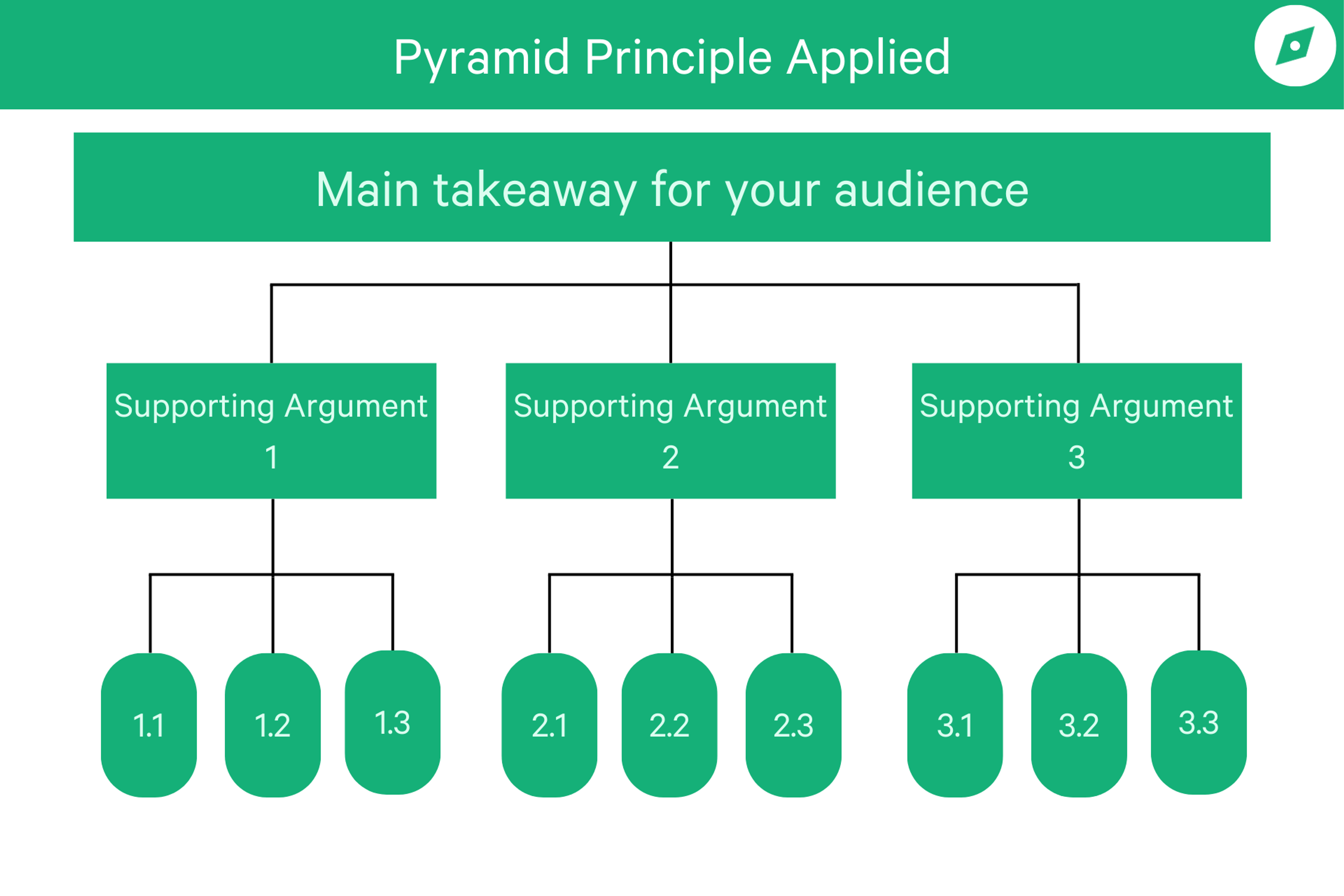The Pyramid Principle in Consulting: What to Know
Master the Pyramid Principle in consulting. Learn how to structure ideas clearly, present solutions effectively, and enhance communication skills with this proven method.
Posted June 13, 2025

Join a free event
Learn from top coaches and industry experts in live, interactive sessions you can join for free.
Table of Contents
Have you ever wondered how top consultants structure their thoughts so clearly and persuasively? It's all thanks to the Pyramid Principle – a method that helps them organize their thoughts in a structured and persuasive way. This approach provides a framework for organizing ideas in a logical, easy-to-follow manner. Whether you're preparing for a case interview or looking to enhance your problem-solving skills, understanding the pyramid principle can give you a significant edge.
In this article, we'll dive into the nuts and bolts of the pyramid principle. You'll learn what it is, why it's so effective, and how to apply it in consulting case interviews. We'll also walk you through a real-world example and show you how to use this method to structure your analysis. By the end, you'll have a solid grasp of this essential consulting technique and be ready to put it into action in your own work.
What is the Pyramid Principle?

Origin and Definition
The Pyramid Principle is a powerful communication methodology developed by Barbara Minto, the first female post-MBA hire and former McKinsey consultant. This approach revolutionized the way consultants structure their thoughts and present information, becoming a cornerstone of effective communication in the consulting world. As a result, it's a strategy often emphasized in top-tier business schools, such as Harvard Business School, where students are trained to think critically and structure their ideas persuasively.
At its core, the Pyramid Principle is a method for organizing ideas in a logical, easy-to-follow manner. It advocates for delivering key conclusions first, followed by supporting information. This "top-down" structure is designed to maximize your time with busy executives who are used to processing information quickly and efficiently.
Importance in Consulting
In the fast-paced consulting environment, the ability to communicate efficiently is crucial. The Pyramid Principle has become an essential tool for consultants to present their recommendations clearly and persuasively. Here's why it's so important:
- Time Efficiency: Executives are perpetually short on time. By starting with the answer to their question, you make the most of your limited time with them.
- Executive Thinking: Many executives think in a "top-down" manner, focusing on the big picture. The Pyramid Principle aligns with this mental model, allowing them to quickly process your recommendation.
- Persuasiveness: Being direct and answering the executive's question first makes you sound more assertive and confident.
- Structured Thinking: The principle helps you group and summarize your supporting arguments logically, ensuring that ideas at any level in the pyramid are summaries of the ideas grouped below them.
- Versatility: While particularly useful in consulting, this approach is applicable anytime you need to convey a persuasive argument or ask someone to do something, regardless of the medium.
The Pyramid Principle Structure
The Pyramid Principle consists of three main parts, each forming a layer of the pyramid:
- The Assertion (Top Layer): This is the most crucial part of the pyramid. It's your key takeaway or the answer to the question at hand. You should lead with this at the top of your presentation or communication, ensuring everyone knows the main point from the start.
- Arguments (Middle Layer): These form the chapters of your story and are the main reasons that prove your assertion is true. Each argument supports your top-level point, providing a logical structure to your communication.
- Data and Details (Bottom Layer): This is the base of the pyramid and should be the most content-heavy section. Here, you provide all the data, case studies, and other research used to reach your conclusion. It's important to include only relevant data that supports your arguments, rather than overwhelming your audience with excessive information.
This structure allows you to group and summarize your supporting ideas logically. Each level in the pyramid should be a summary of the ideas grouped below it. When organizing ideas within each group, you can use different logical orders:
- Time order: Present ideas in a sequence of events that form a cause-effect relationship.
- Structural order: Break a singular thought into its parts, covering all major supporting ideas.
- Degree order: Present supporting ideas in rank order of importance, from most to least important.
Why Is the Pyramid Principle Effective?
The Pyramid Principle is highly effective because it mirrors the way busy executives prefer to receive information – starting with the main point down to the supporting evidence. This approach establishes strong vertical relationships between ideas, making it easier for decision-makers to understand and act on recommendations. Additionally, by structuring detailed information logically, it ensures that all supporting data is relevant and directly tied to the core message, allowing for clear and concise communication.
It Maximizes Time with Busy Executives
Executives are usually short on time and need to process information quickly, especially when you’re only in contact through written communication such as emails, reports, texts, etc. The Pyramid Principle's "top-down" structure addresses this challenge by starting with the answer to the executive's question first. This approach allows you to make the most of your limited time with them, ensuring that the key message is delivered upfront.
Aligns with Executive Thinking
Many executives think in a "top-down" manner, focusing on the big picture rather than getting bogged down by details. By presenting your recommendation in an "answer first" format, you're fitting into the executive's mental model. This alignment allows them to quickly process your recommendation and grasp the main point within the first 10 seconds.
Enhances Persuasiveness
When you're direct and answer the executive's question first, you sound more assertive and confident. This approach makes you more persuasive as you're not searching for reasons or words, and you don't appear to be wavering. It demonstrates that you have a clear understanding of the issue and a well-thought-out solution.
Structures Thoughts Logically
The Pyramid Principle advocates that "ideas in writing should always form a pyramid under a single thought". This structure helps you group and summarize your supporting ideas and arguments logically. By decomposing your argument into a pyramid structure, you ensure that ideas at any level are summaries of the ideas grouped below them.
Facilitates Clear Communication
The pyramid principle's structure dramatically lessens confusion, shortens meetings, and motivates action from stakeholders – which saves us a few minutes of everybody’s time. It helps you cut out the fluff and focus your audience on making a decision: whether to act on or believe your key takeaway. This clarity is crucial in driving action and increasing your organizational influence.
How to Apply the Pyramid Principle in Consulting Case Interviews
Applying the Pyramid Principle in consulting case interviews can significantly enhance your communication and problem-solving skills. This approach, developed by Barbara Minto, an ex-McKinsey consultant, is particularly useful for making decisions and solving problems. Here's how you can effectively use this principle:
1. Start with the answer
Begin by presenting your key message or conclusion to the interviewer. This "answer-first" approach immediately grabs attention and provides a clear direction for the information that follows. Your opening statement should be clear, logical, and impactful.
2. Present supporting arguments
After stating your main point, focus on presenting three main arguments that directly support your key message. This structure makes you sound more organized and prepared. Ensure that each argument relates directly to your recommendation and is logically grouped.
3. Provide supporting data and facts
Once you've made your point and presented your main arguments, move on to sharing the detailed work behind your conclusion. This level contains more specific information, data, and facts that support your key message and arguments.
4. Use the pyramid structure for summaries
Throughout your case interview, use the pyramid structure to provide summaries or recommendations. This approach helps maintain clarity and focus throughout your presentation.
5. Ensure clarity and focus
The Pyramid Principle ensures that the interviewer understands the essentials right from the start. This reduces ambiguity and improves understanding. The hierarchical structure keeps the communication focused on the most important information, avoiding unnecessary details that can distract the interviewer.
6. Be efficient and persuasive
The logical flow and clear organization of ideas save time for both you and the interviewer. This structure allows for quick identification of the most important points and the arguments that support them. A well-structured argument is more convincing, strengthening the overall persuasiveness of your communication.
Case Example of Pyramid Principle
To illustrate the practical application of the Pyramid Principle, let's examine a case study involving a travel company. This example demonstrates how to structure your analysis and recommendations using this powerful communication tool.
The Client's Situation
Your client is a travel company catering to a mature clientele. They're looking to expand their business by targeting new customer segments while maintaining their current customer base. The company's marketing efforts primarily focus on direct mail and catalogs, offering high-priced 7+ day trips.
The key question you need to address is: How should your client adjust their service mix and marketing spend to serve new customer segments and increase revenues by $100 million?
Structuring Your Analysis
Using the Pyramid Principle, start with your main thesis:
"By entering new customer segments, we can increase revenues by $100 million. To achieve this, we need to understand four key areas:"
- Current market and reach
- New priority market segments and how to reach them
- Gaps in the client's capabilities
- Size of the opportunity in terms of revenue and profit
This structure allows you to organize your thoughts logically and present a clear roadmap for your analysis.
Synthesizing Recommendations
After conducting your analysis, use the Pyramid Principle to present your recommendations:
"We can increase revenues by $120 million by entering the travel market for middle-aged professionals. This will require a $32 million investment and take 3 years to grow the business."
Supporting arguments:
- Current mature customer base generates $250 million in annual revenue.
- Priority growth segments include middle-aged professionals seeking shorter, lower-cost trips.
- Client lacks a marketing technology stack (e.g., email marketing capabilities, app management).
- Expanding into the new segment presents an annual opportunity of $120 million in revenue and $28 million in profit.
By structuring your recommendations this way, you provide a clear, actionable conclusion supported by key points and relevant data. This approach aligns with executives' preference for "top-down" thinking and respects their time constraints.
How to Use the Pyramid Principle to Structure Your Analysis
- Start with the Main Point: Begin by identifying the primary conclusion or recommendation you want to convey. In the business world, this main point should be directly tied to the goals of the analysis and should capture the audience's attention immediately.
- Break Down Supporting Arguments: Use MECE (Mutually Exclusive, Collectively Exhaustive) principles to structure your analysis. Ensure that your supporting arguments are mutually exclusive (no overlaps) and collectively exhaustive (covering all relevant points). This helps in presenting ideas clearly and ensures that all aspects of the issue are addressed.
- Organize Data Points Logically: Arrange your supporting evidence and data points in a logical order that supports your main point. Whether you use inductive reasoning (starting with specific data leading to a general conclusion) or deductive reasoning (starting with a general principle and narrowing down), ensure the flow is coherent and easy to follow.
- Use Vertical Relationships: Structure your analysis in a top-down manner, where each section or paragraph flows from the main point. This vertical relationship between ideas allows the audience to quickly grasp the key points and understand how the detailed information supports the overall argument.
- Review and Refine: After organizing your analysis, review it to ensure clarity and coherence. Make sure that each point supports the main conclusion and that your structure aligns with MECE principles. This step is crucial for ensuring that your analysis is both persuasive and easy to understand.
The Bottom Line
The Pyramid Principle greatly improves communication in consulting and beyond. This method helps you organize ideas clearly, making it easier to capture and maintain your audience's attention. By presenting the main point first and backing it up with detailed data, consultants can communicate effectively, especially with busy executives at top consulting firms.
In short, mastering the Pyramid Principle is key to sharpening your problem-solving and communication skills. Whether you're preparing for a case interview or trying to enhance your professional presentations, this approach helps you convey ideas in a way that prompts action and achieves results.
Read these next:
- 50+ Brain Teaser Interview Questions You Could Be Asked
- 50+ Case Interview Questions From Top Firms
- Market Entry Framework: The Expert Guide
- The Expert Guide to Market Sizing Questions (With Examples)
Frequently Asked Questions
What is the Pyramid Principle?
- The Pyramid Principle is a communication technique where information is organized hierarchically. The main idea is presented first, followed by supporting details grouped at the same level, ensuring that each level of information is clear and logically connected.
How do you use the Pyramid Principle?
- To use the Pyramid Principle, start by identifying the most important part of your message, which should be the main idea or conclusion. Then, organize the supporting details logically beneath it, grouping related points together at the same level. This approach ensures that your communication is clear, concise, and focused on the key message.
What are the main points of the Pyramid Principle?
- The Pyramid Principle emphasizes starting with your main message at the top of the pyramid. Below this, you should have three supporting arguments, each underpinned by its own set of reasons. The apex of your pyramid should present an actionable insight, supported by the subsequent layers of arguments.
Can you explain the Pyramid Principle in the context of consulting?
- In consulting, the Pyramid Principle is a communication technique often used by consulting firms and strategy consultants to structure their recommendations and findings. The approach involves presenting the main conclusions or key messages at the top of the "pyramid," followed by the supporting data and rationale underneath. This method helps consultants deliver their insights in a clear, logical, and efficient manner, ensuring that clients can quickly grasp the most critical points before diving into the detailed analysis. It is especially useful in executive-level communication, where time is limited, and concise, impactful messaging is crucial.
Is the Pyramid Principle still applicable today?
- Yes, the Pyramid Principle remains highly relevant in the consulting industry. It is widely used in various scenarios, from internal team discussions to high-stakes presentations for executives. Given that executive attention can be limited, capturing interest within the first few seconds is crucial, and this principle addresses that need effectively.
What are the benefits of using the Pyramid Principle?
- Using the Pyramid Principle offers several advantages: it meets the immediate need for essential information when audience attention is most focused, enhances the efficiency of document preparation, and helps clarify the relationships between different points of discussion.
Browse hundreds of expert coaches
Leland coaches have helped thousands of people achieve their goals. A dedicated mentor can make all the difference.


























